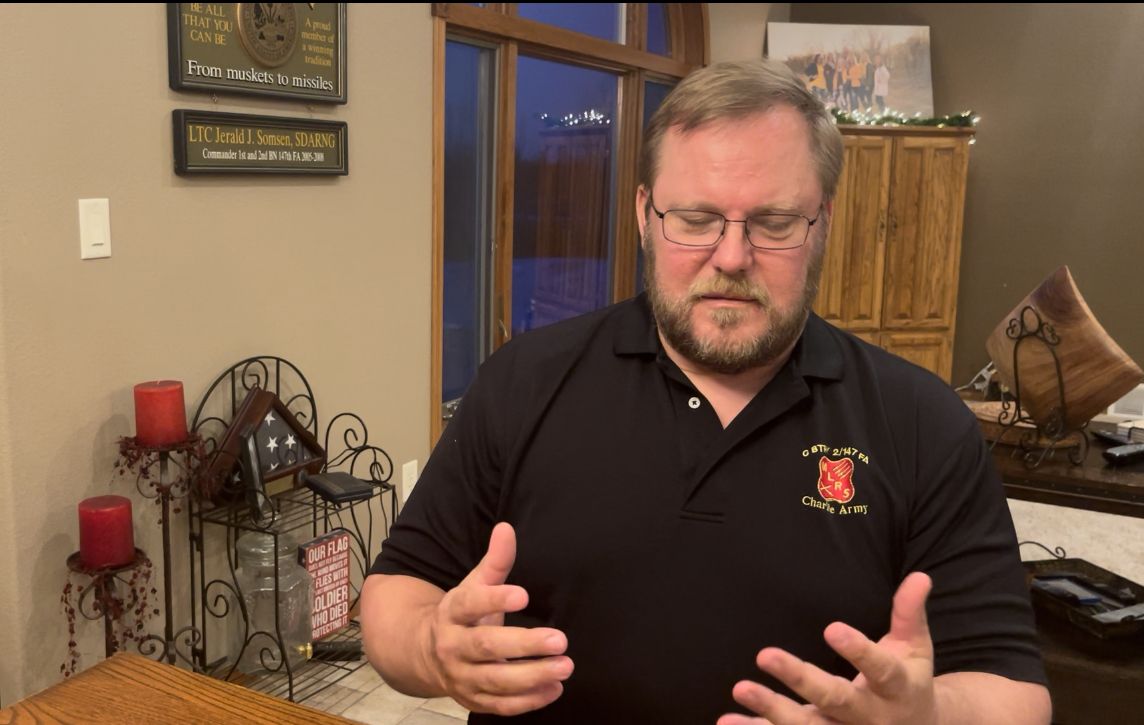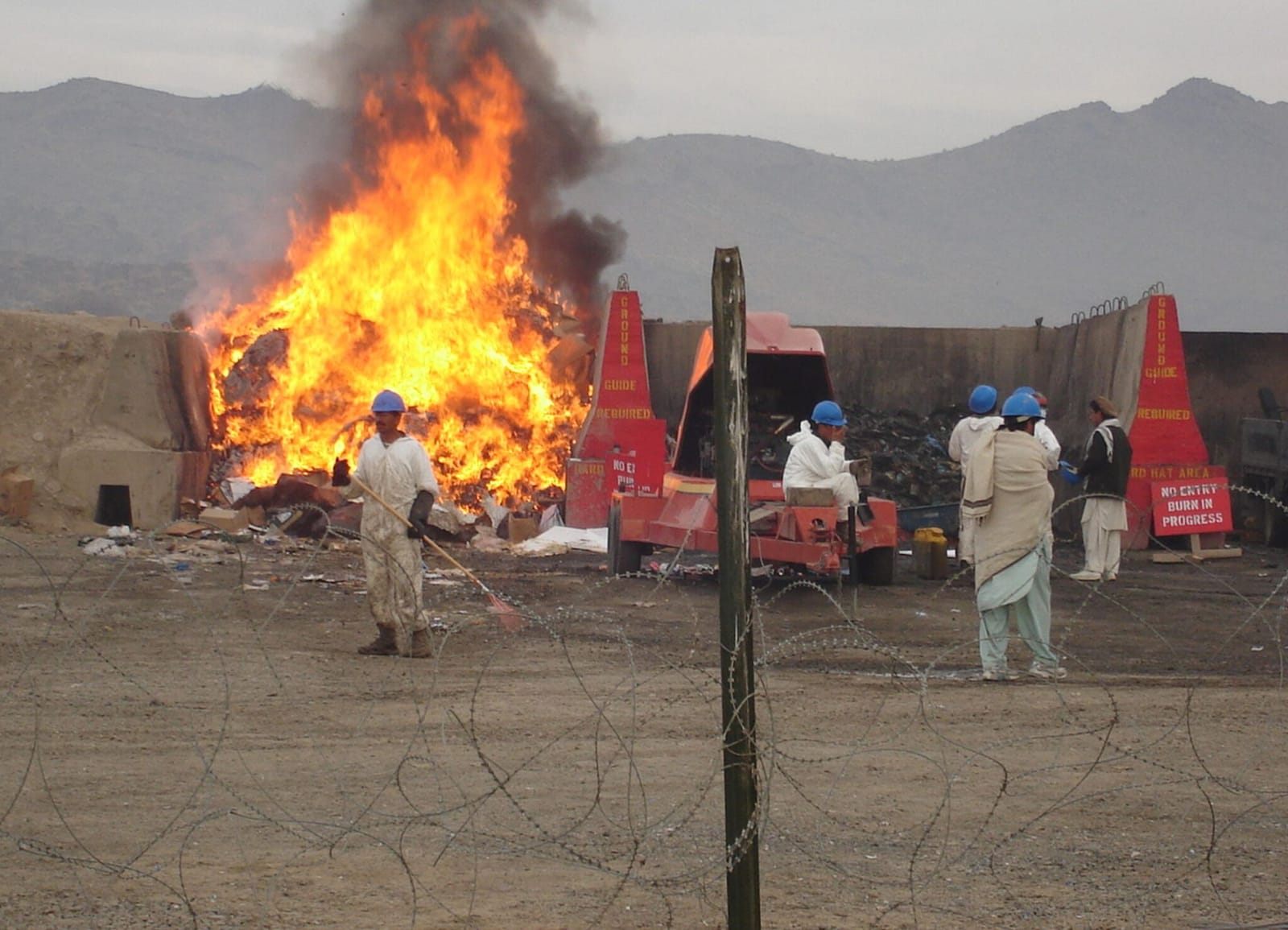Combat veterans in South Dakota are encouraged by new legislation in Congress to expand treatment and benefits for soldiers exposed to toxic burn pits during deployment overseas, but questions remain about the federal government’s ability to effectively provide the needed health care.
Those questions partly explain why Republican senators John Thune and Mike Rounds of South Dakota opposed the PACT Act initially, voting against it twice before public pressure and an agreement to consider GOP amendments swayed their votes to the yes column on Aug. 2. The measure passed the Senate by a vote of 86-11; it was signed into law by President Joe Biden on Aug. 10.
“We want to make promises that we can actually keep,” Rounds told News Watch, referring to backlogs in Department of Veterans Affairs processing that have delayed healthcare claims and referrals, sparking recent controversy and a change of VA leadership in Sioux Falls. “The VA has made it very clear that it can’t handle the influx of additional veterans that are going to be coming forward.”
The Honoring our Promises to Address Comprehensive Toxics (PACT) Act expands healthcare eligibility to about 3.5 million veterans exposed to toxic smoke from burn pits used to dispose of chemicals, munitions and other hazardous materials, mostly in Iraq and Afghanistan, while also extending coverage for illnesses linked to the Agent Orange herbicide in Vietnam.
With an estimated cost of $280 billion over 10 years, the measure also directs more funding toward VA healthcare centers and claims processing, though Rounds and Thune say such efforts will fall short of meeting the increased demand in South Dakota, which has nearly 56,000 veterans, comprising 8.5% of the state’s total population, higher than the national average of 7.1%, according to the 2020 U.S. Census.
U.S. Rep. Dusty Johnson cited the similar logistical concerns while voting against the PACT Act in the House of Representatives, where it passed by a margin of 342-88 in July.
Tom Hafner, state commander of Veterans of Foreign Wars in South Dakota, admitted that procedural issues exist but said those concerns should not have caused South Dakota’s congressional delegation to oppose the groundbreaking veterans aid package.
“I was disappointed,” said Hafner, 73, who served as command sergeant major of his Army National Guard unit during Operation Iraqi Freedom in 2004-05. “They talk about taking care of veterans, and this was one area where that could happen. Whether the VA can adapt or handle more cases shouldn’t have been their concern at the congressional level. Their concern should have been what was good for the veterans of South Dakota.”
Hafner recalled burn pits being a “common, everyday occurrence” during his time in Iraq with the 153rd Engineer Battalion out of Huron. He is one of nearly 24,000 veterans in South Dakota who served in either the Persian Gulf War or post-9/11 operations in Iraq and Afghanistan.
“I would venture to say that nearly every veteran who was deployed to Iraq was exposed to some sort of toxic fumes,” said Hafner, who lives in Parkston. “You’d go by burning oil pits that were smoldering constantly, and there was no way to get away from it. But I don’t think anybody thought anything of it, except in hindsight.”
Hafner suffers from rhinitis, a respiratory condition that causes congestion and makes it difficult to breathe at night. The VA last year added rhinitis and chronic asthma to its list of presumptive conditions, meaning Gulf War era and post-9/11 veterans diagnosed with the ailment are presumed to have gotten it from military service and are covered for treatment through the VA.
The PACT Act adds 23 illnesses to the list of presumptive conditions, including brain cancer, pancreatic cancer and lymphoma. Before this legislation, many veterans have faced situations where they had to prove that their ailments were linked to military service, using VA clinic visits and an appeal process.
This comes at a time of greater recognition of mental illness in the military, with suicide rates of military service members and veterans spiking in recent years, according to U.S. Department of Defense data.
“When you’re that young, it’s all about the mission,” said Connie Johnson, who served in the Army as part of Operation Iraqi Freedom in 2003-04. “You do what you’re told and serve your country and you’re not thinking about your health. Then 10 or 15 years later your body is like, ‘Now you’re going to pay for it,’ whether that’s physically or mentally. And we’re paying for it now. That’s OK, because we did volunteer our time. We just want people to recognize that we served our country and put ourselves in harm’s way, and now some of us are sick and want to be taken care of. That’s not a selfish thing. It’s OK to want to be taken care of.”
Greater awareness about burn pits and broader access to care is important, Connie Johnson added. But expanding the number of veterans who are eligible for care without addressing flaws in the system has her worried about more procedural bottlenecks and more pain and frustration.
“The VA can’t handle us already,” said Johnson, a 38-year-old Elkton native who serves as president of the South Dakota Veterans Council. “I’m worried that it’s just going to cause more heartache.”
Bureaucratic bottlenecks for veterans
Johnson received the Army Commendation Medal and a Purple Heart for injuries suffered when her 101st Military Police Company convoy was struck by a roadside bomb in northern Iraq. She was able to return to duty but dealt with nerve damage and post-traumatic stress disorder after returning to South Dakota, with scars on her neck as a remnant of war.
Because of her documented injuries and medals, Johnson’s experience with continuing care through the VA was mostly positive. But as she became more active in advocating for veterans throughout the state, she realized that her situation was not necessarily the norm.
“I had access that many veterans didn’t have,” said Johnson, a South Dakota State University alum who serves as the school’s coordinator of veteran affairs. “There are people, some of whom went through more than I experienced, who have had to scratch and claw their way into the system. That’s a serious flaw in the process.”
Many of these issues stem from implementation of the VA Mission Act of 2018, which established a Community Care program with the aim of integrating VA medical facilities with private doctors and clinics. This partial privatization was meant to allow more veterans, especially those in rural or remote areas, to receive care without having to physically travel to a VA facility.
But Rounds, one of just five senators to vote against the Mission Act in the Senate, points out that the process creates bureaucratic hurdles. Appointments and claims still must be processed and approved through Veterans Affairs, which in many cases lacks the staff and infrastructure to meet the demand, Rounds said.
“They put gatekeepers in place to keep veterans away from local doctors,” said Rounds, who attended a forum in Sioux Falls in February 2022 to hear veterans air grievances about Community Care in the Sioux Falls VA Health Care System, which serves about 30,000 enrollees. “We wanted to open it up so vets could go to the doctor of their choice and the VA would pick up the bill. The reason the VA is fighting it is that it takes business away from their own facilities, and they also can’t save money by slowing down the services being provided. That’s what the PACT Act will do in its current form. It will delay services for veterans because they don’t have enough resources right now to provide those services.”
In September 2020, the U.S. Government Accountability Office released a review of the Community Care program nationally, noting that the VA had not established a “timeliness goal” for veteran care and that the program was understaffed in many locations. It also pointed out that few community providers were using the VA’s software system to exchange information electronically, leading to backlogs and extended wait times for claims or appointments.
Earlier this year, Lisa Simoneau was reassigned as director of the Sioux Falls VA Health Care System amid concerns about the program, including reports that some vets were placed on hold for nearly an hour as they tried to make appointments. The acting director is Dr. Timothy Pendergrass, who was not made available for an interview with News Watch.
Pendergrass said in a statement that the longest wait time for the week of July 25-29 was four minutes and the average time a scheduler was on the phone was 3:39, according to Sioux Falls VA data.
“We continue to make improvements to provide the best care for our veterans,” Pendergrass wrote in the statement. “Reducing call times was one of our main priorities since this issue was identified and over the last six months, we have made significant changes and improved processes to make scheduling care in the community easier for veterans.”
Greg Whitlock, Secretary of the South Dakota Department of Veterans Affairs, said that while claims decisions and treatment occur through the federal VA system, his department works to help veterans prepare their paperwork and navigate the process with county and tribal service officers throughout the state.
“As veterans grow older, they might not have a smartphone or computer at home to file that claim,” said Whitlock, who has served in the South Dakota Army National Guard since 1975. “Will we see an influx [with the passage of the PACT Act]? Probably. But I think we have the staff to take care of everything in a timely manner, and then it’s up to the VA to process that.”
Connie Johnson has heard much of this talk before. She prefers to take matters into her own hands, advocating for fellow veterans through the Wounded Warrior Project and her work with the Veterans Council and SDSU. She’s married to a former Marine and has three children in addition to running a flower business on her property north of Brandt, 35 miles northwest of Brookings, making her sensitive to the plight of those who have not been as fortunate since returning home.
“There might be more legislation on the way, but as a human being and a veteran, at the cost of what?” Johnson said. “How many hopeless nights do veterans have to go through as they wait for the VA to get its [act] together based on budget numbers and legislative concerns? Because none of that stuff moves fast, and that makes me really sad.”

Political pressure plays a role
Thune and Rounds raised eyebrows among veterans’ groups by standing against the PACT Act in the initial vote June 16, when it passed the Senate 84-14. The burn pits legislation had bipartisan support after being pushed by Biden in his State of the Union speech in March, and both South Dakota senators have forged a political reputation as supporters of veterans’ causes, though neither served in the armed forces.
Controversy flared more than a month later, when the bill had to be voted on again due to a technical issue that originated in the House of Representatives. This time, the bill failed 55-42 in a procedural vote in the Senate, with 25 Republican senators withdrawing their support and Thune and Rounds remaining against it.
Democrats accused their GOP counterparts of lashing out in retaliation for legislative maneuvers that same day that made it possible to pass the Inflation Reduction Act, a victory for the Biden administration. Republicans responded by accusing Senate Majority Leader Chuck Schumer of preventing their amendments on the PACT Act from reaching the floor.
With the burn pits legislation in limbo during this standoff, comedian Jon Stewart, a longtime advocate for veterans and 9/11 first responders, railed against Republican holdouts as their withdrawal of support for the bill in the Senate became national news.
“It is despicable to continue to use Americans, men and women who are fighting for this country, as a political cause for anger you have about separate issues,” Stewart told reporters outside the Capitol. “I’m used to the hypocrisy. I’m used to all of it, but I am not used to the cruelty.”
Rounds, who serves on the Senate Committee on Armed Services, declined to directly respond to Stewart but pointed to a lack of general understanding about the complexities of the VA process and implementation of the Mission Act.
“We’ll take all the help we can get in fighting for veterans,” Rounds told News Watch. “But people really should have accurate information, or it comes back to bite them later on. It’s one thing to make a promise that you’re going to provide all these benefits, but if you don’t have a system that can actually provide them, you haven’t helped the veterans anyway.”
The fact that Rounds and Thune ultimately voted for the PACT Act sheds light on the liability of being on the wrong side of an emotional issue that gains political momentum and which relates to veterans care. No lawmaker, especially from a conservative state with a rich history of military service, wants to be seen as not supporting veterans, regardless of the complexities involved.
Rounds earlier co-sponsored a Senate bill with a much more modest price tag that would have extended the eligibility deadline for combat veterans from five years after their discharge to 10 years while also providing a one-year application window for those who already missed the deadline.
The $1 billion measure, which Rounds called the first phase of a three-phase process, would also have mandated education and training for VA personnel on toxic exposures and expanded federal research in the field.
But the more sweeping PACT Act is the one that came back to the House, though Rep. Johnson voted against it and cast doubt on whether the White House-favored measure could pass the Senate due to the substantial budget numbers involved.
Part of the GOP opposition stemmed from Pennsylvania Sen. Pat Toomey’s claim that the bill “allowed $400 billion of current spending to be moved from the discretionary to the mandatory spending category,” which he said would free up space under spending caps elsewhere that could be used on items not related to veteran care.
“Most of us think [the Democrats] did that on purpose so they can spend that in other areas,” said Rounds. “Now that we’ve drawn attention to it, it will be more difficult for them to get away with it.”
Toomey’s amendment to address that issue failed in the Senate on Aug. 2, as did an amendment from Sen. Marsha Blackburn, R-Tenn., to allow veterans to see a doctor in their community for a primary care appointment that would be reimbursed but not processed by the VA.
When the amendments failed and voting on the PACT Act started, Thune and Rounds joined 84 other senators in voting yes, though Thune expressed reservations in a statement to News Watch.
“Though I continue to have some concerns that this new expansion could overwhelm the VA’s limited staffing capacity and claims-processing apparatus, I ultimately supported the legislation following the consideration of multiple amendments offered by my Republican colleagues after weeks of unnecessary delays by [Senate Majority Leader Chuck Schumer],” Thune said. “But at the end of the day veterans deserve our support and we will do what we need to do to make sure veterans get the care they deserve.”
Sen. Rand Paul, R-Kentucky, drew some backlash for claiming that the bill expands presumptive conditions too broadly, noting that the CDC estimates that 116 million Americans have hypertension, which is one of the conditions presumed to be linked to military service under the PACT Act.
Rep. Johnson made a similar comment during an interview with News Watch earlier this year, saying that determining whether illnesses are linked to burn pits or other elements of military service “needs to be an evidence-based process.” Rounds, however, said the expansion of presumptive conditions wasn’t a factor in his opposition to the legislation.
“I don’t have a problem with that,” he said. “I think that’s the cost of having a war in the first place. If somebody does come up with a cancer or condition that’s unusual and they’ve been in these areas, I don’t have a problem with starting out with the assumption that it’s combat- or job-related. These individuals are going to need to get that care one way or another anyway.”

Finding hope for the future
For Jerry Somsen, the passing of burn pits legislation in Congress is not a time of celebration but cause for further reflection. The 54-year-old Webster native, who helped command an Army National Guard battalion during Operation Desert Storm from 2003-05, started experiencing tremors in his hands after returning home from Iraq, where he and other soldiers regularly encountered smoke on the compound from burning waste and munitions.
When the shaking spread to both sides of his body and down his legs, Somsen was diagnosed with Parkinson’s disease, a progressive nervous system disorder, though he has no family history with the disease.
“I didn’t have this when I went over there, and I came out knowing something was wrong,” the insurance executive said in an interview with News Watch earlier this year. “I guess you could say we signed up for it, but we didn’t sign up to not be protected once we got back.”
Somsen receives medication for his condition through the VA but has been denied disability benefits because the VA does not recognize Parkinson’s as being connected to burn pit exposure, citing research from the National Academy of Sciences, Engineering and Medicine. The illness is not listed among the presumptive conditions added by the passage of the PACT Act, so Somsen’s disability status has not changed.
“Parkinson’s is basically falling through the cracks,” he said the day after the bill passed the Senate.
But Somsen, who retired in 2009 after 23 years of National Guard service, sees a lot of positives from recent attention paid to the burn pits issue. He said he heard from veterans across the county after his story was featured by News Watch, and many of those service members will be getting help now that the legislation has passed.
“Anything we can do to help veterans out is what I’m after,” he said. “It’s amazing how many people have reached out to me to talk about what they’re going through, whether it’s neck cancer or respiratory illness or melanoma. I’m glad that people are going to get help, but it’s unnerving to hear about all the stuff that’s out there and wonder if something couldn’t have been done earlier.”
Somsen said there are good days and bad days with his condition. The tremors come and go without warning, but medication sometimes helps. He worries about his ability to continue to support his family and be active in the community, not to mention spending quality time with his wife, Kari, and their four daughters.
But he holds out hope, especially since the term “burn pits” has become part of the American vernacular – much like Agent Orange became associated with Vietnam – and public pressure has been brought to bear on leaders entrusted with overseeing the welfare of those who serve their country, even long after that service is done.
“It’s good to see more awareness, but it’s sad that these service members were exposed in the first place and there weren’t protections put in place at the time,” said Kari Somsen. “But hindsight is 20/20, and at least now there appears to be a recognition from the government that, ‘Yes, this is something harmful that service members were exposed to, and they should be compensated for it. I would say that’s a good thing.”






